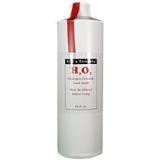 Hydrogen peroxide comes in a variety of grades designed to address its varied and different functions; many of which are designed to address long-term storage properties which alter the composition of the peroxide.
Hydrogen peroxide comes in a variety of grades designed to address its varied and different functions; many of which are designed to address long-term storage properties which alter the composition of the peroxide.
In general, for the purposes of the average person, either drug store/grocery store or food grade H2O2 are the grades which will be useful.
Drug store/grocery store grade hydrogen peroxide, available in a 3 percent solution is always stabilized to increase shelf life of the product. For this reason it is not an appropriate solution for use in food preparation or the cleaning of food preparation surfaces or equipment.
It is, however, perfectly safe to use in such applications as laundry, general cleaning or applications in which it does not come into prolonged direct contact with plants, animals or humans.
Manufacturers of drug store grade hydrogen peroxide do not, as a rule, identify the stabilizers used in their product; however, it is well known that the most common stabilizer of H202 is acetanilide. Other agents known to be used as stabilizers include phenol, tin, Colloidal stannate, organophosphonates, and nitrate.
It was discovered in 1948 that acetanilide is toxic to the liver in humans if ingested, which is why it was removed from use as a fever reducing drug at that time.
Because all hydrogen peroxide is manufactured by chemical companies, the actual stabilizers used and in what concentrations are quite often stated as being ‘proprietary formulations’ which are not disclosed to the public. For this reason, it is unreasonable to assume that any hydrogen peroxide sold commercially, regardless of its grade, unless it is food grade hydrogen peroxide, is safe for consumption, food preparation or direct contact.
While decades of use have shown that the drug store variety is not harmful for cleaning up scrapes and bruises, as this is a rather infrequent and insignificant topical use, and it has been stated in recent years by drug companies and other authority sources that this store brand/drug store variety is considered safe for mouth rinsing in concentrations of 50% (relative concentration thereby being 1.5%), but if that is as far as they are willing to go, there should be considered to be a reason, and that reason is most likely the stabilizers contained in the products.
The other grades of hydrogen peroxide range from beauticians grade (bleaching) which comes in concentrations starting at around 6%, all the way to specialized rocket fuels and ultra-purified concentrations used in the space program.
Technical and industrial grades are also manufactured in concentrations ranging from 20 to 70 percent for use in industrial, chemical and manufacturing applications. Typically, these grades also contain proprietary formula stabilizers which are designed to address specific needs of industry and are not fit for use in food preparation or for agricultural or domestic home uses.
In 2007, the FDA approved a new line of 35% Food Grade peroxide products for aquaculture use which must be marketed under the brand name PEROX-AID®. Clearly, if the FDA wants to ensure that the grades and stabilizers in hydrogen peroxide used in aquaculture are safe, then it only makes sense that any peroxide used in the home kitchen be food grade peroxide.
Hydrogen Peroxide Uses – Medical Uses
H2O2 Uses – Pool & Spa